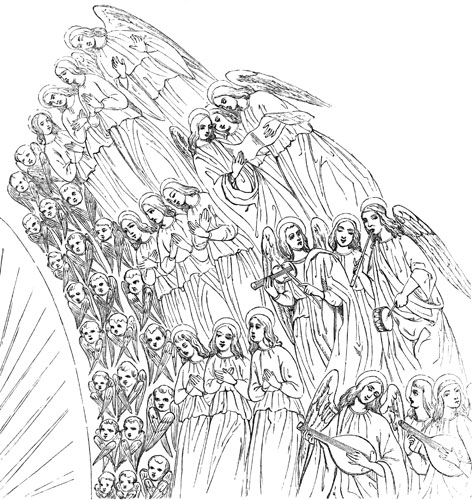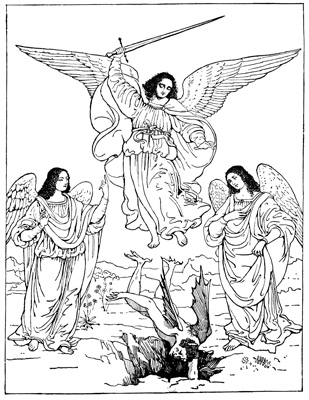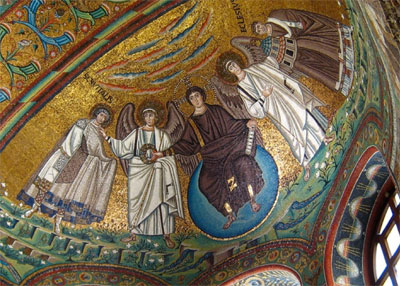There have been many curious conceits introduced into some of the early religious pictures, and two instances in which little seraphim and angels are perched on trees, near the Virgin and Holy Child. The idea seems to be that these “Birds of God” — as Dante calls the angels — are making music and singing for the Divine Infant, some of them also praying for his solace. . . . → Read More: Seven Holy Angels
|
|
|||
|
Santa Eufemia, Verona – Interior Raphael is frequently represented without wings when leading Tobias, who — in order to emphasize the contrast between an angel and a mortal — is made very small, and is thus manifestly out of keeping with the story. When the wings appear there is no reason for dwarfing Tobias, and the picture is far more satisfactory. It is not difficult to discern that if the story of Tobias is considered as an allegory, the young man personates the Christian, guided and guarded through life by God’s mercy. . . . → Read More: Archangel Raphael: Part 2 The Archangel Raphael is esteemed as the guardian angel of the human race. He especially protects the young and innocent, and guards pilgrims and travelers from harm. It was he who warned Adam of the danger of sin, and declared to him its dread consequences. . . . → Read More: Archangel Raphael: Part 1
In the legends of St. Michael we read that in the sixth century, when the plague was raging in Rome, and processions threaded the streets chanting the service since known as the Great Litanies, the Archangel Michael appeared, hovering over the city. . . . → Read More: Archangel Michael: Part 3 The Archangel Michael is reverenced as the first and mightiest of all created beings. He was worshiped by the Chaldeans, and the Gnostics taught that he was the leader of the seven angels who created the universe. After the Captivity the Hebrews regarded him as all that is implied by the Prophet Daniel when he says, “Michael, the great prince which standeth for the children of thy people.” . . . → Read More: Archangel Michael: Part 1
The Archangel Gabriel is mentioned by name but twice in the Old Testament. First in Daniel viii., 16, when he explained the vision which the prophet had seen, and again in Daniel ix., 21, when Gabriel appeared to Daniel to give him skill and understanding. Likewise in the New Testament he is twice mentioned– in Luke i., 19 and 26, when he announced to Zacharias the birth of John the Baptist, and to the Virgin Mary that she was favored of the Lord, and blessed among women. On each of those occasions he filled the office of a messenger or bearer of important tidings. . . . → Read More: Archangel Gabriel: Part 1
The earliest instance of the Archangels introduced by name into a work of art is in the old church of San Michele at Ravenna (A. D. 545). The mosaic in the apse exhibits Christ in the centre, bearing in one hand the cross as a trophy or sceptre, and in the other an open book on which are the words, “Qui cidef me videt et Patrem meum” [John xiv. 9]. On each side stand Michael and Gabriel, with vast wings and long scepters; their names are inscribed above, but without the Sanctus and without the Glory. It appears, therefore, that at this time, the middle of the sixth century, the title of Saint, though in use, had not been given to the Archangels. . . . → Read More: Archangels: Part 2
There are several angels who in artistic representations have assumed an individual form and character. These belong to the order of Archangels, placed by Dionysius in the third Hierarchy: they take rank between the Princedoms and the Angels and partake of the nature of both. Like the Princedoms, they have Powers; and, like the Angels, they are Ministers and Messengers. Frequent allusion is made in Scripture to the seven Angels who stand in the presence of God. (Rev. viii. 2, xv. 1, xvi. 1, etc.; Tobit xxii. 15.) This was in accordance with the popular creed of the Jews, who not only acknowledged the supremacy of the Seven Spirits, but assigned to them distinct vocations and distinct appellations, each terminating with the syllable El, which signifies God. . . . → Read More: Archangels: Part 1 |
|||
|
Copyright © 2024 Christian Image Source - All Rights Reserved |
|||



 St. Michael at the Castle of San’ Angelo, Rome by Matthias Kabel
St. Michael at the Castle of San’ Angelo, Rome by Matthias Kabel Archangel Art
Archangel Art
 Archangel Pictures
Archangel Pictures Apse Mosaic, San Vitale, Ravenna
Apse Mosaic, San Vitale, Ravenna
Guardian Angels
The Angel of Peace by Wilhem von Kaulbach
From the classification of the angelic hosts by the early theologians, and the special duties assigned to each class, we learn that the word angels, as ordinarily used, refers to archangels and angels only; these two classes are associated with human life in all its phases . . . . . . → Read More: Guardian Angels